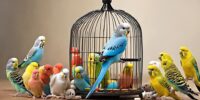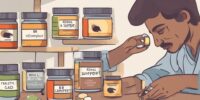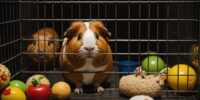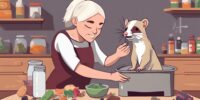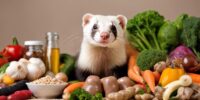How to Create an Enriched Environment for Parrots Mimicking Their Natural Habitat

Creating an enriched environment for parrots involves providing a variety of mental and physical stimulation opportunities. This can include offering a diverse range of toys, perches, and foraging activities to keep the birds engaged and entertained.
Additionally, incorporating social interaction, such as spending quality time with the parrots and providing opportunities for them to interact with other birds, can help promote their well-being.
Furthermore, ensuring a healthy diet, regular exercise, and a safe living space are essential components of creating an enriched environment for parrots.
By implementing these key strategies, parrot owners can help ensure that their feathered friends lead happy and fulfilling lives.
Providing Proper Perching Options
When creating an enriched environment for parrots mimicking their natural habitat, it's crucial to provide a variety of proper perching options that cater to their natural behaviors and physical needs. Branch perches and platforms should be strategically placed throughout the aviary to allow the parrots to roost comfortably and exhibit their natural perching behaviors. Branch perches of varying diameters help exercise their feet and prevent foot problems such as arthritis. Platforms offer resting spots and mimic natural tree canopies where parrots would typically gather.
In addition to branch perches and platforms, incorporating rope swings and ladders into the environment provides parrots with opportunities for physical activity and mental stimulation. Rope swings simulate the swaying movements of tree branches, engaging the parrot's balancing skills and core muscles. Ladders offer vertical movement, allowing parrots to navigate different levels within their living space.
Offering Diverse Foraging Opportunities

To enhance the parrots' cognitive abilities and natural foraging instincts, caregivers should offer a diverse range of foraging opportunities within their enriched environment. Interactive puzzles and food challenges are excellent ways to engage the parrots' minds and provide stimulation similar to what they would experience in the wild.
| Foraging Opportunity | Description | Benefits |
|---|---|---|
| Interactive puzzles | These puzzles require the parrots to solve problems to access food hidden inside, stimulating their problem-solving skills. | Enhances cognitive abilities and keeps the parrots engaged. |
| Food challenges | Food challenges involve placing treats in hard-to-reach areas, encouraging the parrots to work for their food. | Mimics natural foraging behaviors and promotes physical activity. |
Incorporating Natural Sounds and Enrichment Toys

Incorporating natural sounds and enrichment toys can enhance the sensory experiences of parrots in their enriched environment, promoting mental stimulation and overall well-being. Parrots are intelligent creatures that thrive on mental stimulation, and the inclusion of natural sounds and interactive toys can provide them with a more engaging and enriching environment.
Key Points:
- Natural Sounds: Introducing natural sounds like recordings of rainforest ambiance or calming bird calls can help create a more realistic and comforting environment for parrots, mimicking their natural habitats.
- Interactive Toys: Providing parrots with a variety of interactive toys such as puzzle feeders, foraging toys, or toys that encourage physical activity can keep them mentally engaged and physically active, promoting sensory stimulation and environmental enrichment.
- Enrichment Benefits: The combination of natural sounds and interactive toys not only serves as a form of entertainment but also aids in reducing boredom, decreasing stress levels, and improving overall well-being for parrots in captivity.
Creating Safe Flight Spaces

Regularly assessing and optimizing the spatial layout and environmental features of aviaries is crucial for ensuring the creation of safe flight spaces for parrots in captivity. When designing aviaries, it's essential to consider the flight dynamics of parrots. The aviary design should accommodate their natural flight patterns, allowing for adequate space to fly, hover, and perch comfortably. Safety precautions must be implemented to prevent collisions with walls or obstacles. Providing branches and perches at varying heights can encourage natural behaviors and aid in flight exercise.
Behavior observation is key to understanding how parrots interact with their flight spaces. Monitoring their movements and reactions can help identify any areas of the aviary that may need adjustments for improved safety and enrichment. Regularly inspecting the aviary structure for wear and tear is essential to prevent accidents. By creating safe flight spaces that mimic their natural habitat and incorporating proper safety measures, caregivers can promote the physical and mental well-being of parrots in captivity.
Simulating Varied Light and Temperature Conditions
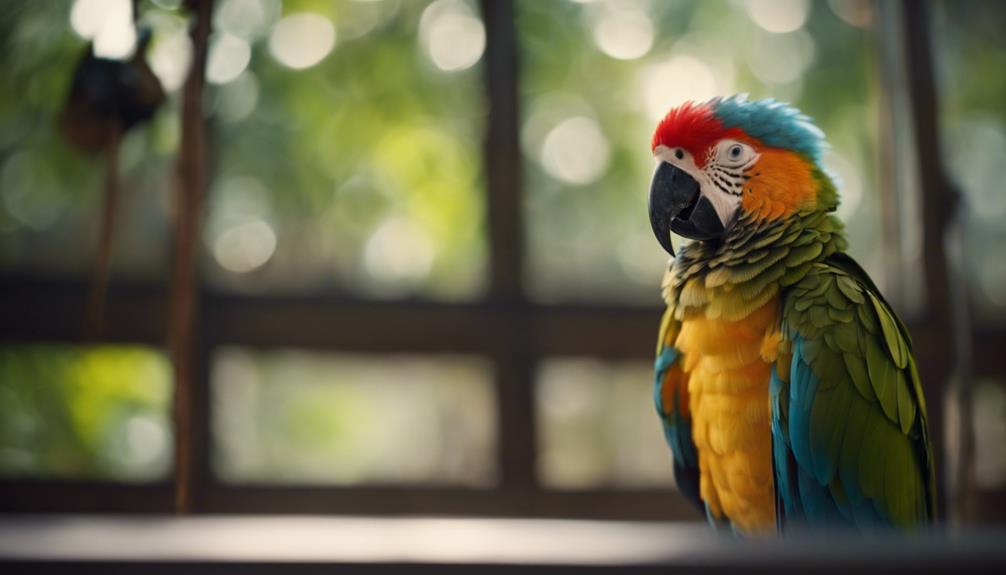
To create an environment that closely mimics the natural habitat of parrots, it's essential to consider simulating varied light and temperature conditions. Maintaining a balance between light and shade is crucial as it mirrors the changing patterns of sunlight in the wild.
Additionally, setting up a temperature gradient helps provide parrots with the opportunity to regulate their body temperature effectively.
Light and Shade Balance
Ensuring a balanced interplay of light and shade in the parrot's environment is crucial for replicating the varied light and temperature conditions found in their natural habitat. This aspect of natural habitat simulation has a significant behavioral impact on parrots and plays a vital role in maintaining their health through appropriate light exposure.
- Natural Rhythms: Mimic the changing light conditions throughout the day to align with the parrot's natural circadian rhythms.
- Shade Options: Provide areas of varying shade intensity to allow the parrot to self-regulate its exposure to light.
- UVB Lighting: Consider incorporating UVB lighting to ensure the parrot receives the necessary UV rays for vitamin D synthesis and calcium metabolism.
Temperature Gradient Setup
Creating a temperature gradient setup is essential in replicating the varied light and temperature conditions found in a parrot's natural habitat, facilitating their physiological well-being and behavioral enrichment. To achieve this, it's crucial to have a well-designed ventilation system that allows for proper air circulation and control of temperature variances within the enclosure.
Additionally, incorporating play structures that offer different levels of warmth and light exposure can help create zones for the parrots to regulate their body temperature effectively. Humidity control should also be considered, as it plays a significant role in mimicking natural environmental conditions.
Implementing Vegetation and Hideouts

Parrots thrive in environments that mirror their natural habitats, where vegetation provides enrichment through foraging opportunities and mental stimulation.
Additionally, incorporating hideouts such as branches, wooden structures, or artificial foliage can offer security and a sense of safety for these intelligent birds.
Greenery for Enrichment
Introducing a variety of plant species into a parrot's habitat can significantly enhance their environmental enrichment. Plant diversity offers natural foraging opportunities and visual stimulation, mimicking their wild environment.
Canopy cover provides shade and a sense of security for the parrots, reducing stress levels. Climbing structures and hanging vines not only encourage physical activity but also replicate the vertical dimension that parrots would explore in the wild.
These additions promote natural behaviors like climbing and perching, contributing to the overall well-being of the parrots. By incorporating these elements, caregivers can create a stimulating and engaging environment that meets the physical and psychological needs of their feathered companions.
Shelter for Security
To enhance the sense of security for parrots in their habitat, implementing vegetation and hideouts provides essential shelter options for these avian companions. Parrots have specific nesting preferences, often choosing cozy, enclosed spaces for breeding. Providing nesting materials like twigs, leaves, and shredded paper can encourage natural nesting behaviors.
Roosting spots are also crucial for parrots, as they feel safe and secure when perched high above the ground. Mimicking their roosting habits in the wild, offering branches or platforms at varying heights can cater to their needs.
Hideouts such as birdhouses or dense foliage can serve as retreats for parrots, allowing them to escape perceived threats and relax. By incorporating these elements into their environment, caregivers can promote a sense of security and well-being for their feathered friends.
Ensuring Social Interaction and Stimulation

Social interaction and stimulation play vital roles in maintaining the psychological well-being and cognitive development of parrots in captivity. To ensure the well-being of parrots, it's crucial to provide opportunities for social bonding, cognitive challenges, and environmental enrichment.
- Social Bonding: Parrots are highly social creatures that thrive on interaction with their own kind or their human caregivers. Providing opportunities for parrots to engage in social interactions helps prevent feelings of loneliness and boredom, promoting their mental health.
- Cognitive Challenges: Parrots are intelligent animals that require mental stimulation to prevent boredom and behavioral issues. Incorporating cognitive challenges such as puzzles, foraging activities, and training sessions can keep their minds active and engaged.
- Environmental Enrichment: Creating an environment that offers behavioral diversity is essential for the well-being of captive parrots. Including a variety of perches, toys, and hiding spots can stimulate their natural behaviors, keeping them physically and mentally healthy.
Frequently Asked Questions
What Are the Benefits of Incorporating Natural Sounds and Enrichment Toys for Parrots in Their Environment?
Incorporating natural sounds and enrichment toys for parrots provides behavioral enrichment, promotes cognitive development, encourages natural foraging behaviors, and offers sensory stimulation. These elements enhance the overall well-being and mental health of parrots in captivity.
How Can I Ensure That the Flight Space for My Parrot Is Safe and Secure?
Ensuring flight space safety for a parrot involves securing perches and toys properly. Regularly inspecting the environment for any potential hazards like sharp edges or toxic materials is essential. Maintaining a clean and spacious area is crucial for their well-being.
What Are the Considerations for Simulating Varied Light and Temperature Conditions in a Parrot's Habitat?
Considerations for simulating varied light and temperature conditions in a parrot's habitat involve establishing lighting schedules for natural rhythms and regulating temperature gradients. Providing foraging opportunities and climbing structures can enhance mental and physical stimulation for the parrots.
How Can I Effectively Implement Vegetation and Hideouts in My Parrot's Living Space?
When enriching a parrot's living space, it's essential to include climbing structures for exercise, foraging opportunities for mental stimulation, natural perches for comfort, and hiding spots for security. These elements mimic their natural habitat, promoting overall well-being.
What Are Some Creative Ways to Ensure Social Interaction and Stimulation for My Parrot on a Daily Basis?
Incorporate foraging games and training exercises to engage the parrot's mind. Provide socializing opportunities and enrichment activities for a stimulating environment. These activities mimic the parrot's natural instincts, fostering a thriving and interactive daily routine.



